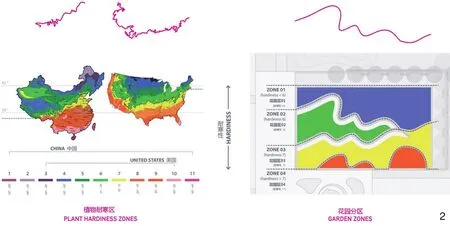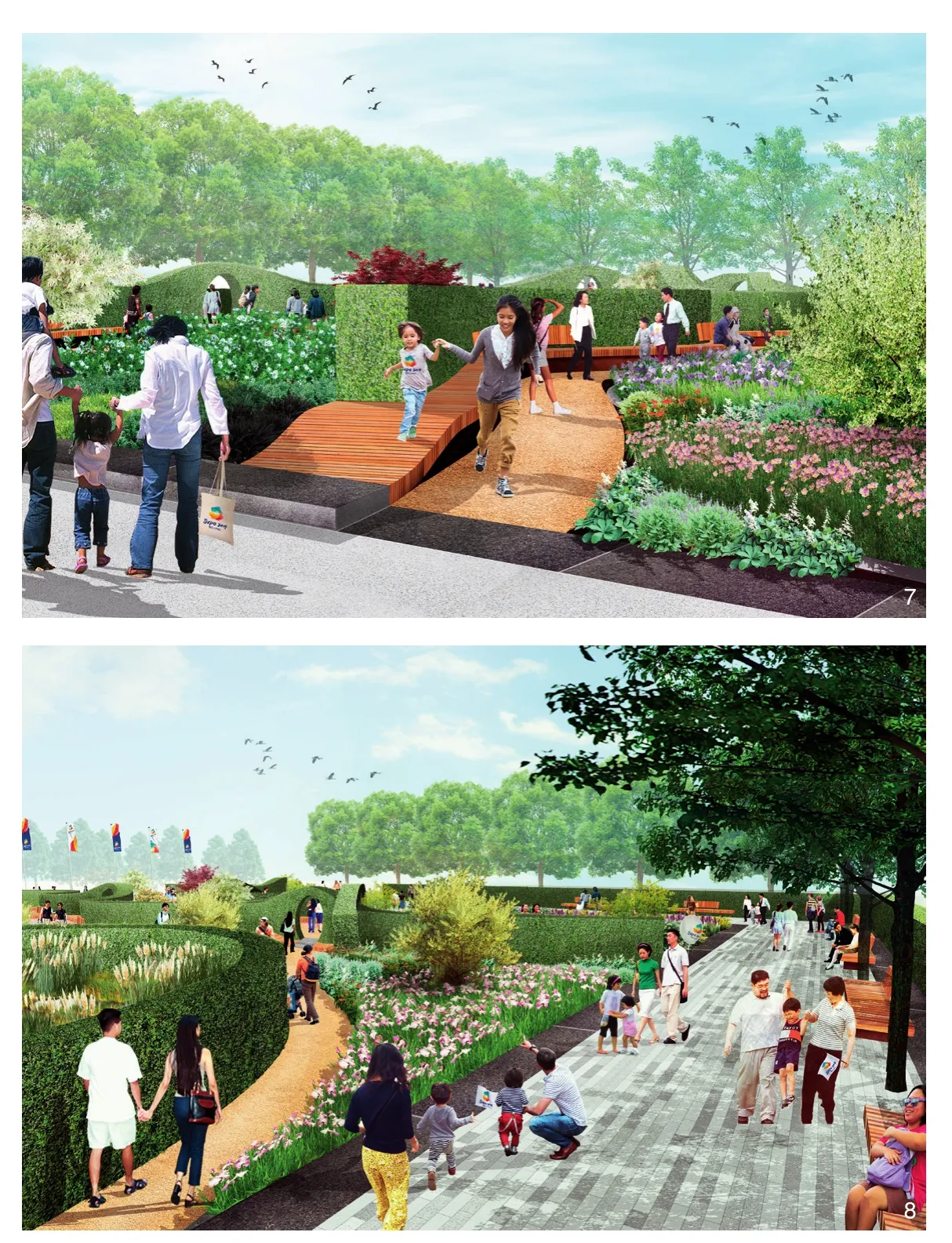东西园
2018-05-10乔治哈格里夫斯
(美)乔治·哈格里夫斯

1 花园设计概念“东西园”The garden concept: East and West

2 花园分区象征了中美共有的植物耐寒区The Garden Zones represent the common plant hardiness zones in China and US
世界上近1/8的植物(约31 000种独特物种)都起源于中国。在过去的几千年里,它们中的大多数被出口到世界上其他(生境)相似的地区进行培育,经由人为力量完成了全球大迁徙。因此,从常见的城市植物种类的角度看,世界上很多国家和地区都与中国有着内在的地理—空间联系。这一现象在美国尤为明显,如今,美国各地的公共空间和私家花园里的许多常见植物都产自中国。例如,在旧金山人们经常可以看到为人行道提供遮阴的银杏(Ginkgo biloba)或榔榆(Ulmus parvifolia),以及鸡爪槭(Acer palmatum)、丁香属灌木(Syringasp.)、蔷薇科栒子属的地被植物(Cotoneastersp.)和鼠尾草属的宿根植物(Salviasp.)。在美国各地(和其他地区)设计和建造公园的实践经验为我们提供了一种独特的视角去看待这一反复出现的主题。这个看似不为人知的园艺故事,也是哈格里夫斯事务所设计的创意花园—“东西园”—试图去探索的。
植物耐寒区(plant hardiness zones)通常指植物能够生存、生长的地理区域。它受到当地气候、天气模式和海平面等因素的影响。通过对中国与美国植物耐寒区异同的一系列研究,可以明显发现中国除了在热带区域的跨度更大以外,两国植物耐寒区分布相似,这为中国植物在美国繁殖扩散提供了可能。
在2019北京世界园艺博览会的创意展园设计中,我们将2 030m2的花园划分为4个相互交织的“花园区”,每个区域都代表了一个中国与美国共有的植物耐寒区。一条条整齐修剪的密植绿篱分隔和界定了每一个花园区,绿篱的曲线在微观层面上象征性地模拟了宏观真实世界中植物耐寒区的分界线。通过用同一种绿篱贯穿整个花园,使绿篱成为中性元素,绿篱之间的环境成为视觉焦点。每个花园里的植物都取样自由中国“迁徙”至美国的植物,并被分别种植在对应的象征性的植物耐寒区里。当穿行在整个花园中时,会感受到强烈的视觉对比和戏剧般的冲突体验。
每个花园区内,都包含3种不同的种植元素:点、线、面。宽度不尽相同的线状种植由灌木和地被植物组成。面状元素则是由花岗岩条带围合而成的质感细腻的大型灌木。点状元素藉由孤植的大型灌木或丛生小乔木来强调空间。花园中所有的植物都来源于中国,同一物种均种植在同一组团。通过这种方式,每个花园区都解构了一种中国的生境类型,同时,这种结构也呼应了美国的植物耐寒区。区域1创建了代表平原和灌木林生态类型的环境,区域2代表山地森林区,区域3代表草地生境,区域4代表湿地。下文将详细介绍每个分区的种植初步设计。
区域1的“平原和灌木林”由对比强烈的花卉条带和绿色的“点”“面”构成,其中,花卉条带象征了在平原和灌木林地区传统的人工防风林带。条带的高度和色彩富于变化:紫色的香薷属植物(Elshotziasp.)向上生长,黄色的棣棠(Kerria japonica)浓密饱满,白色的落新妇‘奇幻’(Astilbe arendsii‘Astary’)像漂浮的气球。它们是如此耀眼,即使有一些大型植物(点、面)阻隔视线,也能吸引穿越花园的目光。
质感和季节变化是区域2的重点,表现了在山地环境中的阔叶植物的景象。枝叶浓密的偃松(Pinus pumila)充当“面”,生长于多刺的木樨属(Osmanthussp.)、大明竹属(Pleioblastussp.)、野扇花属(Sarcococcasp.)植物,及暗色调的叶形修长的沿阶草(Ophiopogon planiscapus‘Nigrescens’)之间。在“线”“面”之上,开花优雅而壮观的猬实(Kolkwitzia amabilis)成为焦点,就像山坡上一处自然的点缀。
在区域3,颜色和气味刺激着来访者的感官。观赏草和野花组成了“线”和“面”,就像在自然界的草地中一样。不同的“线”和“面”互相独立,每条“线”或每个“面”都只种植一种植物,分别展示野花草地生境中的不同元素。带有香味的野棉花(Anemone hupehensis)、花朵尺寸和质感对比明显的鸢尾属植物(Irissp.)和紫花唐松草(Thalictrum rochebrunianum)集中种植在小径旁边,营造了独特的花园互动体验。

3 平面图Site Plan

4 鸟瞰图Bird eye view
区域4展示了潮湿的热带湿地,特别是那些绿的像要溢出的草本植物。芒属植物和芦苇生得高大,在区域3就能被(远远)看到,吸引着人们前来探索的好奇。深红色的白茅(Imperata cylindrica‘Rubra’)在苔草属(Carexsp.)和菖蒲属(Acorussp.)植物之间闪耀,让人在外面的创意花园广场上就能看见。包括斑叶芒(Miscanthus sinensis‘Zebrinus’)在内的这些植物的颜色和质感的碰撞,鼓励人们前来探索东西园。
与植物变化相呼应的是4个花园区相互间的高差为0.15m(大约是一个台阶的高度),这是从世界各地普遍存在的植物耐寒带随海拔高度变化的现象中获得的灵感。当高度一致的绿篱和每片花园区域边缘的阶梯地形相结合时,会营造出一种独特的视觉效果:前方总是开放的,而后方总是围合的,从而激发(访客的)好奇心与探索欲。
紧靠树篱的坐凳既迎合了台地地形,又在所有边缘提供了连续的休憩空间,让游人可以自由选择他们喜欢的位置休憩与放松。坐凳由大地色调的耐候钢支撑,顶部由横向木条构成,强调了花园区和绿篱的曲线形态。坐凳的局部设置靠背,为老年人提供了和朋友、家人一起休憩的舒适空间。
在花园中,路径系统划分了不同种类的可达空间以及与之配合的游览体验。一条由花岗岩铺砌而成的规整而宽阔的散步道沿着花园2个方向的边界延伸。在这里,长木凳掩映在浓密的树荫下,这是花园中仅有的乔木。散步道提供了充足的宽度,使不同规模的团体都能在此活动,为社交创造了一个平台。在这里,人们还可以俯瞰各个花园区,并在局部地区观赏到优雅的曲线绿篱之间的视觉通廊。在花园中,多条砾石铺就的小径渗透其中,让参观者通过看、听、闻与植物充分互动,得到充分的互动体验。在花园里有5处坐凳表面向下延伸而绿篱墙垂直向上,这打破了连续的视线,暴露出倾斜的椭圆形开口,引导游客在这里从一个花园区穿越到另一个花园区,就像穿越到另一个世界的门。
每当夕阳西下,暮色渐沉,景观灯就相继亮起,照亮每个花园区的独特种植元素。在区域1,随机布置的条形灯由下至上照亮了花卉条带。在区域2的“山地森林区”,点状射灯照亮了有明显季相变化的大型灌木。在草地生境区,小型草坪灯被随机安排在组团状的草地植物中,照亮那些盛开的宿根花卉,并营造了一种行走于萤火虫间的氛围。
在整个设计中,细节的改进和材料的运用也极受重视。切割整齐的花岗岩石板同园路、植物组团一起限定了整个花园的边界。而在花园内部,花岗岩石板仅在绿篱开洞处出现。在花岗岩限定的框架内部,颜色鲜亮的木坐凳、沿花园外围布置的条状坐凳以及坐凳下方的耐候钢也在各个环境中重复出现。连贯的花岗岩、木材和耐候钢,同每个区域的植物一起营造了一种独特而永恒的场所感。
东西园揭露了大多数人不熟悉甚至闻所未闻的中美两国间的园艺联系。从这个意义上讲,在花园里漫步的体验不仅试图唤起人们对园艺学新的认识,更是激发一种未被发现的自由的想象。这个花园是为梦想家设计的。你可以对这个花园和里面的植物产生无限遐想;你可以想象着植物从东方迁徙至西方的漫长旅程,乃至在全球环境中中国和北美之间其他千丝万缕的联系;你可以想象着孩子们在花园中学习,或者是简单地享受盛开的花朵的美丽和芬芳;你可以在花园里梦想,甚至你会在离开后还会梦见这座花园。
在2019年北京世界园艺博览会上,我们很高兴在我们的小花园“东西园”中分享我们对这种令人惊叹的园艺故事的理解,我们期待着和你一起体验和逐梦。
(编辑/王一兰)
花园名称:东西园
设计单位:哈格里夫斯事务所
项目名称:2019年北京世界园艺博览会创意展园D32地块
项目地点:中国,北京,延庆
设计时间:2017.9—2017.12
建造时间:2018
建设面积:2 030m2
项目团队:乔治·哈格里夫斯,米斯蒂·马奇,马特·佩罗托
翻译:韩婕玉
校对:张博雅

5 花园概念剖面Diagrammatic Section

6 花园植物构成:每个分区代表一个植物耐寒区The composition of plantings in garden: each garden zone represents a plant hardiness zone in real world
Nearly one eighth of the worlds plants (roughly 31,000 unique species) are native to China. Over the past few millennia, many of these species have undergone a global migration from the exportation to - and cultivation in, other similar regions of the world. In this way, many places have an underlying geo-spatial relationship with China, regarding prevalent plant species in local urban ecology and public spaces. This is especially true in the United States where, throughout the country, a wide variety of the plant species commonly planted in public and private landscapes are native to China. On any given day in San Francisco for example, it is common to seeGinkgobilobaorUlmus parvifoliatrees shading sidewalks, andAcer palmatumtrees, a variety ofSyringaspp.shrubs,Cotoneasterspp.groundcovers,andSalviaspp. perennials in parks and openspaces.Designing and implementing landscapes throughout the United States (and internationally) has provided us with a unique insight towards this reoccurring theme, and it is this seemingly untold horticultural story that Hargreaves Associates’ creative garden EAST AND WEST seeks to explore.
Commonly used to spatially define the geographic areas where individual plant species survive and/or thrive, plant hardiness zones are in fluenced by factors such as local climate, weather patterns, and height above sea level. After a series of mapping exercises to understand the commonalities between China and the United States, it was evident that while China experiences a greater range in tropical extremes, both countries share a similar range in plant hardiness zones, thus allowing for the proliferation of Chinese plants in the United States.

7 、8 效果图Renderings
The design for the 2,030m2garden plot at the International Horticultural Exhibition 2019, divides the site into four weaving and intersecting “Garden Zones”, each representing one of these shared hardiness zones. Densely planted topiary hedge rows both separate and define each of the Garden Zones. The curvilinear hedge row geometries signify a micro interpretation of the seemingly free flowing organic nature of the macro hardiness zones in the real world, and their neutral character draws visual emphasis on the environments within. Each Garden Zone is comprised of plantings which represent a small sample of the migrated species from China to the United States, and also grow in the respective plant hardiness zone, creating a visual contrast and a dramatically different experiential character as you move through the design.
Within each of the Garden Zones, the planted areas contain three distinct planting elements; bars, clouds, and accents. The bars are comprised of rows of varying widths that are planted with individual shrub and groundcover species,the fine textured clouds contain larger sized shrubs edged with granite curbs, and the accents punctuate the spaces with the largest, individually planted specimen shrubs species. By planting these elements as groups of the same species, each of the Garden Zones display plants native to China in a method that deconstructs one of China’s various ecotypes, while at the same time compositionally maintaining a setting that might also be found in the United States—Zone 1 creates an environment representative of a Plains and Shrubland ecotype, Zone 2 becomes Montane, Zone 3 as Wild Meadows, and Zone 4 as Wetlands. The following paragraphs describe the preliminary planting design within each zone in more detail.
Zone 1’s plains and shrubland is de fined by the contrast of the flowing bar species meant to represent the traditional monocultured rows of windbreaks, with the woody green cloud and accent plantings. The varied height and brightly colored linear bars—the violet vertical stature of theElsholtziasp. and the dense circular yellowKerria japonicaagainst the floating white blooms of theAstilbe arendsii‘Astary’—draw the eye across the full length of the garden whilst the layering of the foliage-rich clouds and accents plantings both impede and separate to enable such views.
Texture and seasonality are brought forth in the plantings of Zone 2,representing the visual character of succulent type species that grow in the rugged environmental conditions of the montane. The dense evergreenPinus pumilacloud plantings lie amongst the parallel bars of pricklyOsmanthussp.,Pleioblastussp.,andSarcococcasp., juxtaposed by the dark hues of theOphiopogon planiscapus‘Nigrescens’s long grassy blades. Sitting above the bars and clouds, the large graceful blooms of theKolkwitzia amabilisaccent specimens become the focus, as if highlighting the natural speckling of hill and mountain slopes.
Color and Smell engage the senses of Zone 3 garden explorers. Just as in natural wild meadows, ornamental grasses and wildflowers make up both the bar and cloud planting elements. The monocultured arrangements of the bar and clouds create groupings of single species as if displaying a separation of the individual wild meadow ecotype components. When adjacent to walkways, the groupings of species allow for focused scents like those of theAnemone hupehensisand the touch of the varying sized blooms of theIris’s against theThalictrum rochebrunianum, to create a unique source of interaction with the garden.
The textures of Zone 4 represent the saturated grasses of tropical humid Wetlands. Spreads of large reeds and sedge typeMiscanthussp. are visible from within the Wild Meadows of Zone 3 and create a sense of curiosity to discover what lies beyond. Viewed from the adjacent Creative Gardens Plaza to the west, the deep red color of theImperata cylindrica‘Rubra’ are sprinkled throughout the emergentCarexsp. andAcorussp. that line the upper wetland shelf. Engaged by this play on color in combination with the textures of theMiscanthus sinensis‘Zebrinus’, visitors in the Creative Gardens Plaza are encouraged to enter and explore the East and West garden further.
Complimenting the varied planting selection, each of the four Garden Zones terrace in height by 0.15m (approximately the height of one step tread),drawing inspiration from the stepped gradient in elevation above sea level typically experienced among plant hardiness zones globally. The consistent height of the hedge rows creates a unique eyelevel datum that when combined with the stepping topography at the edge of each Garden Zone, provides a feeling of openness to the garden in front and enclosure behind, encouraging a sense of curiosity to explore and discover.

9~11 效果图Renderings
Seatwalls adjacent to the hedge rows both retain the terracing topography and provide a consistent seating element along their full length, allowing garden explorers the freedom to find their own place to sit and unwind. The top of the seatwalls are made of lateral wood slats that emphasizes the curvature of the Garden Zones and hedge rows, and sit above a corten steel base of earthy color tones. Segments of the seatwalls have backrests of consistent materials that allow the elderly a comfortable place to relax with friends, family, and loved ones.
A hierarchy of paths delineate the various types of accessible spaces and associated experiences within the garden. A wide formalized promenade constructed of granite pavers extends along two sides of the garden perimeter where long wood slat benches lie beneath substantial shade trees.The promenade’s generous width has a capacity for both large and small groups, creating a forum for socializing while providing vantage points which overlook the terraced layering of the Garden Zones,and create rare moments where view corridors open from between the gracefully curving hedge rows.Within the garden, a network of informal paths made of decomposed granite permeate through the garden,allowing visitors to see, smell, and touch the plantings in a fully interactive experience. At five moments within the garden the seatwalls push downward and the hedge rows stretch vertically upward, breaking away from their consistent eyelevel height, to expose tilted elliptical openings which enable garden goers to move from one Garden Zone to another—an experience as if entering a gateway to another world.
As the sun goes down and the day turns to dusk, landscape lighting illuminates the different planting character elements that uniquely define each Garden Zone. In Zone 1, randomly spaced strip-lights highlight the foliage of the flowering bar plantings from below. In Zone 2’s Montane,the seasonal interest accent plantings are lit by spot up-lights. And in the Wild Meadows of Zone 3,small post-top lights are randomly hidden within the meadow plantings of the clouds, illuminating the grasses and perennials in bloom and creating a sense of walking amongst fire fly’s.
Much attention has been given to the re finement of details and the distribution of materials throughout the design. In addition to the formal pathway and the cloud planting edging, wide architecturally cut granite slabs frame the entire garden—a feature only reoccurring within as the single step tread below the hedge openings. Richly colored wood slats form the top of the seatwalls and the linear benches along the garden perimeter, and the rusted corten steel facing beneath each is also repeated below the granite slab frames in their own condition. In combination with the array of plantings in each Garden Zone, the consistent use of granite, wood, and corten steel creates a unique sense of place and a timelessness like no other.
EAST AND WEST exposes the horticultural relationship between two nations that is most often forgotten, and unknown to many. In this sense,the experience of walking through the garden is intended to evoke not just a new understanding about horticulture, but an unfound freedom to imagine. The garden is for dreamers; you can dream about the garden and the plants within; you can dream about the migration of plants from the East to the West, or the many other ways that the global environment might relate between China and North America; you can dream about your children learning in the garden, or simply enjoying the beauty and fragrances of the flowers in bloom. You can dream while you’re in the garden, and you’ll even dream about the garden once you’ve left.
We are excited to share our interpretation of this amazing horticultural phenomenon in our small garden design EAST AND WEST at the International Horticultural Exhibition 2019, Beijing, and we look forward to experiencing and dreaming with you.
